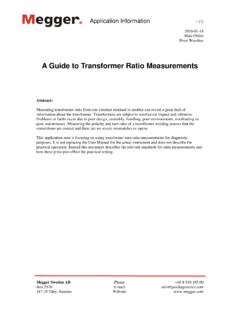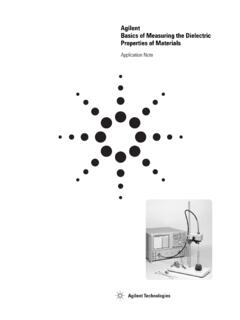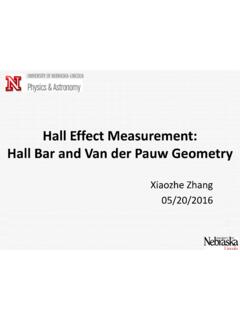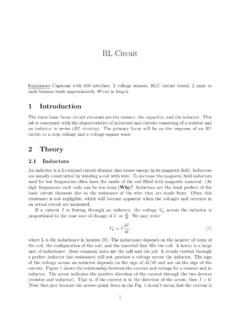Transcription of Guide to Transformer Resistance Testing 100406
1 Application Information1 (20) 2010-04-06 Matz Ohlen Peter Werelius Megger Sweden AB Phone: +46 8 510 195 00 Box 2970 E-mail: 187 29 T by, Sweden Website: A Guide to Transformer Winding Resistance Measurements Bruce Hembroff, CET, Manitoba Hydro Matz Ohlen, Megger Sweden Peter Werelius, Megger Sweden Abstract: Measuring a Transformer 's DC Resistance from one external terminal to another can reveal a great deal of information about the Transformer . In addition to the obvious faulted winding ( , an open winding or shorted turn), more subtle problems can be detected. The DC current, in addition to flowing through the winding, must also flow through the off-load ratio adjusting switch (RA switch), the on-load ratio adjusting switch (load tap changer or LTC), as well as numerous welded and mechanical connections. Hence, the integrity of all these components can be verified. Authors note: Specific aspects of safety are addressed herein; however comprehensive procedures are not detailed.
2 It is assumed the operator has sufficient knowledge of electrical theory and safe working practices to use the test instrument in a safe and responsible manner. Application Information2 (20) 2010-04-06 Matz Ohlen Peter Werelius Megger Sweden AB Phone: +46 8 510 195 00 Box 2970 E-mail: 187 29 T by, Sweden Website: Content1 Introduction .. Resistance measurements (WRM) .. 32 Winding Resistance Measurements When? .. Installation .. Routine (scheduled) Transformer Maintenance .. Adjusting Switch (ratio adjusting off-load tap changer) .. Tap Changer .. Unscheduled Internal Transformer Inspections .. 53 Test Equipment .. 54 measurement principle .. 55 Safety Considerations .. Test Current .. of Safety Precautions .. 76 Selecting the Proper Current Range .. 87 Measurements .. Switch Measurements .. 98 Connections .. Windings .. Windings .. 109 Interpretation of Measurements .. Factors .. change.
3 Oxidization .. measuring error .. Bad is Bad? .. 1210 Isolating Problems .. Switch .. Switch Observation .. Switch Observation .. Switch Observation .. vs. Connectors or Joints .. 1411 Limitations .. 1412 Figures and Tables .. 1513 References .. 20 Application Information3 (20) 2010-04-06 Matz Ohlen Peter Werelius Megger Sweden AB Phone: +46 8 510 195 00 Box 2970 E-mail: 187 29 T by, Sweden Website: A Guide to Transformer Winding Resistance Measurements 1 Introduction General This application note is focusing on using winding Resistance measurements (WRM) for diagnostic purposes. The intention of this reference manual application Guide is to Guide the operator in the appropriate method of making winding Resistance measurements on power transformers and assist in the interpretation of test results obtained. It is not a complete step-by-step procedure for performing tests and is not replacing the user manual for the actual instrument.
4 Before performing any test with an instrument, read the user manual and observe all safety precautions indicated. Winding Resistance measurements (WRM) Winding Resistance measurements in transformers are of fundamental importance for the following purposes: Calculations of the I2R component of conductor losses. Calculation of winding temperature at the end of a temperature test cycle. As a diagnostic tool for assessing possible damage in the are subject to vibration. Problems or faults occur due to poor design, assembly, handling, poor environments, overloading or poor maintenance. Measuring the Resistance of the windings assures that the connections are correct and the Resistance measurements indicate that there are no severe mismatches or opens. Many transformers have taps built into them. These taps allow the ratio to be increased or decreased by fractions of a percent. If any of the ratio changes involve a mechanical movement of a contact from one position to another, these tap changes should also be checked during a winding Resistance test.
5 Regardless of the configuration, either star or delta, the measurements are normally made phase to phase and comparisons are made to determine if the readings are comparable. If all readings are within one percent of each other, then they are acceptable. Keep in mind that the purpose of the test is not to duplicate the readings of the manufactured device, which was tested in the factory under controlled conditions and perhaps at other temperatures. 2 Winding Resistance Measurements When? At Installation Risk of damage is significant whenever a Transformer is moved. This is inherent to the typical Transformer design and modes of transportation employed. Damage can also occur during unloading and assembly. The damage will often involve a current carrying component such as the LTC, RA Application Information4 (20) 2010-04-06 Matz Ohlen Peter Werelius Megger Sweden AB Phone: +46 8 510 195 00 Box 2970 E-mail: 187 29 T by, Sweden Website: switch or a connector.
6 Damage to such components may result in a change to the DC Resistance measured through them. Hence, it is recommended that the DC Resistance be measured on all on-load and off-load taps prior to energizing. If the Transformer is new, the Resistance test also serves as a verification of the manufacturers work. Installation measurements should be filed for future reference At Routine (scheduled) Transformer Maintenance Routine maintenance is performed to verify operating integrity and to assure reliability. Tests are performed to detect incipient problems. What kind of problems will the Resistance test detect? Ratio Adjusting Switch (ratio adjusting off-load tap changer) Contact pressure is usually obtained through the use of springs. In time, metal fatigue will result in lower contact pressure. Oxygen and fault gases (if they exist) will attack the contact surfaces. Additionally, mechanical damage resulting in poor contact pressure is not uncommon.
7 ( A misaligned switch handle linkage may result in switch damage when operated). Such problems will affect the DC Resistance measured through the RA switch and may be detected. Load Tap Changer The LTC contains the majority of the contacts and connections in the Transformer . It is one of few non static devices in the Transformer and is required to transfer load current several thousand times a year. Hence, it demands special consideration during routine maintenance. In addition to detecting problems associated with high Resistance contacts and connectors, the Megger winding tester will also detect open circuits (drop-out test). LTCs transfer load current. An open circuit would likely result in catastrophic failure. On installation and after maintenance it is certainly prudent to verify operating integrity by checking for open circuits. LTC maintenance often involves considerable disassembly and the test will provide confidence in the reassembly.
8 It is recommended DC Resistance measurements be made on all on-load and off-load taps to detect problems and verify operating integrity of the RA switch and LTC. At Unscheduled Maintenance/Troubleshooting Unscheduled Maintenance generally occurs following a system event. The objectives of unscheduled maintenance are: To detect damage to the Transformer . To determine if corrective action is necessary. To establish priority of corrective action. To determine if it is safe to Transformer faults or problems will cause a change in the DC Resistance measured from the bushings (shorted turns, open turns, poor joints or contacts). Hence, the information derived from the Resistance test is very useful in analyzing faults or problems complimenting information derived from other diagnostic tests such as FRA, DFR, power factor and other measurements. The winding Application Information5 (20) 2010-04-06 Matz Ohlen Peter Werelius Megger Sweden AB Phone: +46 8 510 195 00 Box 2970 E-mail: 187 29 T by, Sweden Website: Resistance test is particularly useful in isolating the location of a fault or problem and assessing the severity of the damage.
9 At Internal Transformer Inspections Internal inspections are expensive due primarily to the cost of oil processing. When such opportunities do present themselves the inspection should be planned and thorough. Prior to dumping the oil, all possible diagnostic tests including the Resistance test should be performed. 3 Test Equipment Prior to modern digital electronic equipment, the Kelvin Bridge was used. Batteries, switches, galvanometers, ammeters and slide-wire adjustments were used to obtain Resistance measurements. Current regulators were constructed and inserted between the battery and the bridge. Input voltage to the regulator of 12 volts dc from an automobile storage battery provided output currents variable in steps which matched the maximum current rating of the bridge on the ranges most used on transformers. The current regulator increased both speed and accuracy of the bridge readings. The approximate 11 volt availability was used to speed up the initial current build-up and tapered off to about 5 volts just before the selected current was reached and regulation started.
10 When the regulation began, the current was essentially constant in spite of the inductance of the windings and fluctuation of the battery voltage or lead Resistance . The Testing times have been greatly reduced using modern microprocessor based test equipment. Direct readings are available from digital meters and on some testers like the Megger MTO series, two measurement channels are available allowing two Resistance measurements at the same time. 4 measurement principle Winding Resistance is measured with the following setup; A DC test current is injected across the measured winding (-s), the voltage drop as well as the test current is measured and the Resistance is calculated. Application Information6 (20) 2010-04-06 Matz Ohlen Peter Werelius Megger Sweden AB Phone: +46 8 510 195 00 Box 2970 E-mail: 187 29 T by, Sweden Website: For purely resistive objects the measurement is trivial and very easy to perform. However, when the measurement circuit is highly inductive, the so called simple application may become rather complex.






